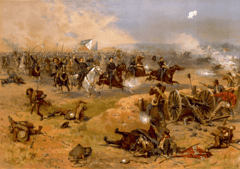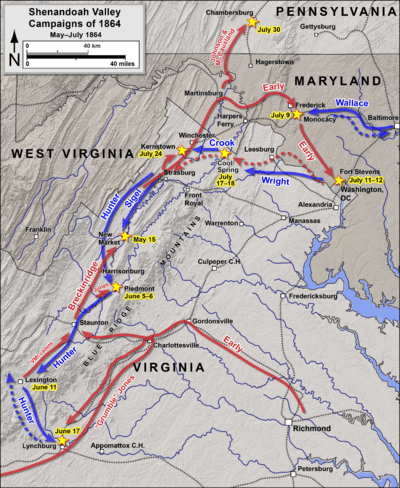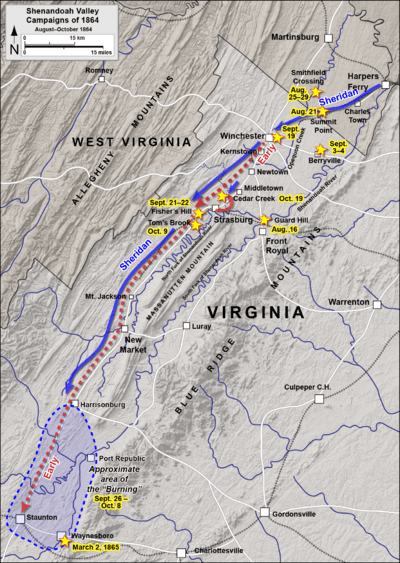Valley campaigns of 1864 facts for kids
The Valley campaigns of 1864 were a series of important battles during the American Civil War. They took place in the Shenandoah Valley of Virginia from May to October 1864. These campaigns were part of a larger plan by Union General Ulysses S. Grant to defeat the Confederate forces. They involved many fights and movements that built on each other.
Contents
Why the Valley Was Important
In 1864, Ulysses S. Grant became the top general for all Union armies. He believed the war would only end if the Confederate forces and their ability to fight were completely destroyed. This idea is sometimes called "total war." Grant planned a big attack from many directions. One key part was to send Union troops into the Shenandoah Valley. The Valley was important because it supplied food and other goods to the Confederate army. It also offered a way for Confederate troops to attack Washington, D.C..
Grant's main plan was:
- Grant and General George Meade would fight Robert E. Lee's army near Richmond, Virginia.
- General Franz Sigel would go into the Shenandoah Valley to cut off Lee's supplies.
- General William Tecumseh Sherman would attack Georgia and capture Atlanta.
- General Nathaniel P. Banks would try to capture Mobile, Alabama.
The First Valley Fights (May–June 1864)
The first part of the Valley campaigns began with General Sigel leading Union troops into the Shenandoah Valley. His goal was to destroy a Confederate railroad, hospital, and supply center in Lynchburg, Virginia.
Battle of New Market (May 15)
Sigel's forces met Confederate troops led by General John C. Breckinridge. Among the Confederate soldiers were young cadets from the Virginia Military Institute (VMI). The Confederates won this battle, and Sigel's troops had to retreat. After this, General David Hunter took over from Sigel.
Battle of Piedmont (June 5–6)
General Hunter continued the Union attack. He defeated Confederate General William E. "Grumble" Jones at the Battle of Piedmont. General Jones was killed in this fight. Hunter then took control of Staunton, Virginia.
Hunter kept moving south. On June 11, he fought Confederate cavalry near Lexington, Virginia. Hunter's troops burned the home of a former Virginia Governor. They also shelled and burned the Virginia Military Institute (VMI) in revenge for earlier attacks by VMI cadets.
Hunter's forces continued towards Lynchburg. Confederate General Jubal Early and his troops arrived in Lynchburg on June 17. Hunter thought he was outnumbered and was also running low on supplies. He decided to retreat back through West Virginia.
Early's Attack on Washington (June–August 1864)
Confederate General Robert E. Lee was worried about Hunter's actions in the Valley. These actions threatened important railroad lines and supplies for his army. So, Lee sent General Jubal Early and his troops to clear the Union forces from the Valley. Early's mission was also to threaten Washington, D.C.. Lee hoped this would make Grant send troops away from the fighting near Petersburg, Virginia.
Early started well. He moved through the Valley without much trouble. He went past Harpers Ferry, West Virginia, crossed the Potomac River, and entered Maryland. Grant quickly sent troops to defend Washington and chase Early.
Battle of Monocacy (July 9)
Early defeated a smaller Union force led by General Lew Wallace near Frederick, Maryland. This battle was important because it slowed Early down. This delay gave the Union army enough time to strengthen Washington's defenses.
Battle of Fort Stevens (July 11–12)
Early attacked a fort on the edge of Washington's defenses. He was not successful and had to pull his troops back across the Potomac River into Virginia.
Other Fights as Early Retreated
As Early's troops moved back, there were several smaller battles. Union cavalry attacked Early's supply wagons. Early also fought and pushed back Union forces that were chasing him at a place called Cool Spring. Another fight happened at Rutherford's Farm, where a Union division defeated a Confederate division. Early then moved his army south to Fisher's Hill.
Second Battle of Kernstown (July 24)
Union General Wright thought Early was no longer a threat and started to leave the Valley. Early attacked him to stop or delay his return to Grant's army. The Union troops were defeated and retreated. Early chased them and burned Chambersburg, Pennsylvania. This was done in revenge for Hunter's earlier destruction in the Valley.
Later Cavalry Fights (August)
There were a couple more cavalry battles. At Folck's Mill, there was a small, undecided fight. At Moorefield, Union cavalry surprised and defeated Confederate cavalry who were returning from burning Chambersburg.
Sheridan's Shenandoah Valley Campaign (August–October 1864)
Grant was tired of Early's actions in the Valley. He knew Washington was still at risk. So, he chose a new, aggressive commander: General Philip Sheridan. Sheridan was given command of all Union forces in the area, called the Army of the Shenandoah. Sheridan started slowly at first. This was partly because a presidential election was coming, and President Abraham Lincoln wanted to avoid any big Union defeats.
Early Skirmishes (August–September)
Confederate forces were sent to help Early. There were several smaller fights as the two armies moved around. At Guard Hill, Union cavalry surprised some Confederate troops. At Summit Point and Smithfield Crossing, Early and his reinforced army fought Sheridan's troops, but the Union forces held their ground or made planned retreats. At Berryville, Early tried to stop Sheridan's march but pulled back when he saw Sheridan's full strength.
Third Battle of Winchester (September 19)

Sheridan learned that Early had spread out his forces. So, Sheridan attacked Early's camp near Winchester, Virginia. This was the biggest battle of all the Valley campaigns. Early's army suffered heavy losses and had to retreat to Fisher's Hill.
Battle of Fisher's Hill (September 21–22)
Sheridan attacked Early again at Fisher's Hill with a surprise attack on their side. The Confederates were defeated and retreated further south.
With Early's army weakened, the Valley was open to the Union. Sheridan then began a "scorched earth" campaign. This meant his army destroyed crops, barns, mills, and factories. The goal was to stop the Confederacy from getting food and supplies from the Valley. This tactic was similar to what General Sherman would do later in Georgia.
Battle of Tom's Brook (October 9)
As Early tried to chase Sheridan, Union cavalry defeated two divisions of Confederate cavalry.
Battle of Cedar Creek (October 19)
Early launched a surprise attack and badly damaged two-thirds of the Union army. However, Early's soldiers were hungry and tired. They stopped fighting to take supplies from the Union camp. General Sheridan, who was away at the time, rode quickly back to the battle. He managed to rally his troops, and they completely defeated Early's men. This big Union victory helped President Lincoln win re-election.
What Happened Next
After defeating Early and destroying the Valley's ability to supply the Confederate army, Sheridan returned to help Grant at the siege of Petersburg. Most of Early's soldiers also rejoined Lee's army in December. Early stayed in the Valley with a small force. He was defeated again in March 1865. After this, General Lee removed him from command because people had lost trust in him.
Images for kids




